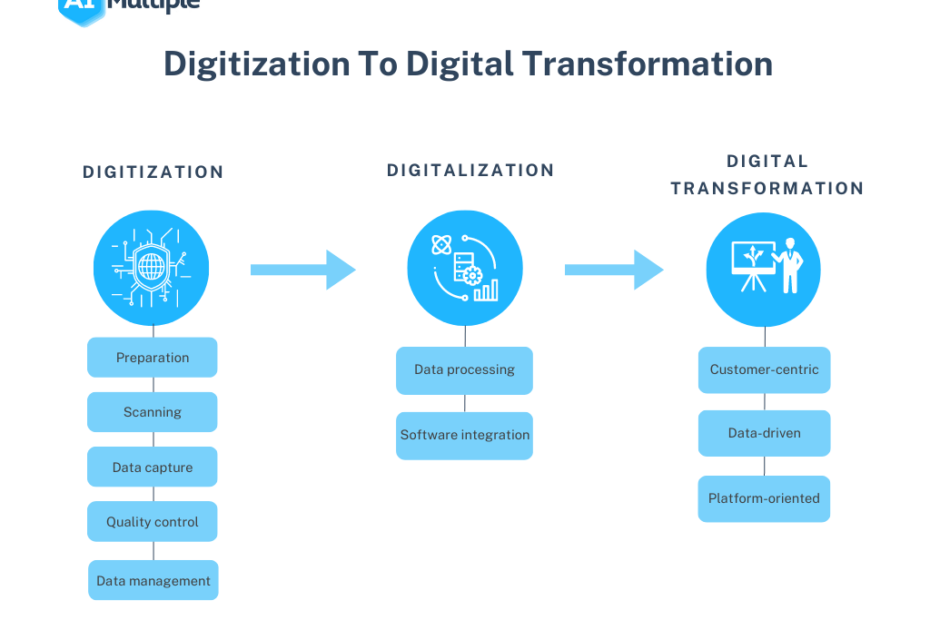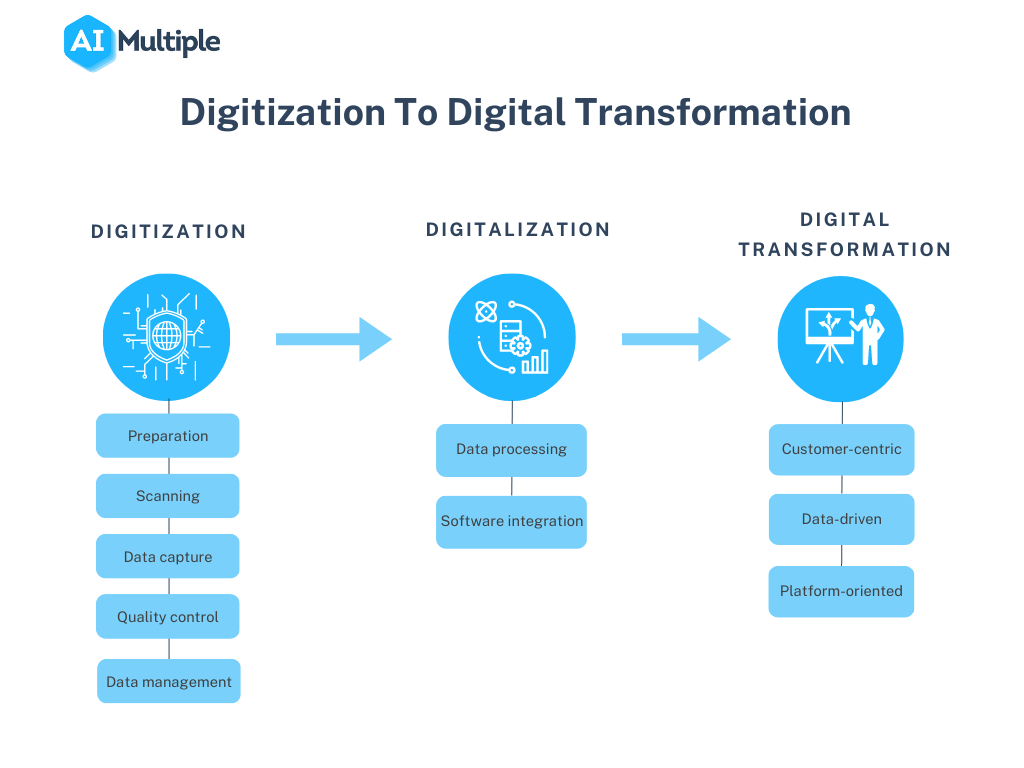Digital transformation is an imperative for most organizations today, with approximately 92% of executives believing it is crucial for business success.1 However, around 86% of digital transformation projects fail to meet objectives.2 A major reason cited for these failures is internal resistance from employees. To drive successful transformation, management must clearly communicate the tangible benefits of digitization to stakeholders across the organization.
In this expanded article, I will leverage my expertise in data extraction and analysis to delve deeper into the strategic value of digitization in 2024 and beyond. Drawing upon over a decade of experience in web scraping, data mining, and process automation, I will provide additional details, data, and perspectives to deliver an insightful 2,000+ word guide.
What is Digitization?
Digitization is the first step in any digital transformation initiative. It involves converting physical documents, images, videos, and other analog media into digital formats that can be processed, analyzed, and shared electronically.
Popular digitization techniques include:
- Optical character recognition (OCR) to convert scanned documents and PDFs into searchable and editable text
- Intelligent document capture (IDC) using AI to automatically classify and extract data from documents
- Media digitization to convert legacy video, audio, and images into digital files
The digital assets generated via digitization underpin subsequent digital transformation efforts focused on automating processes, deriving data insights, and creating new digital products and services.
Figure 1: Steps to Digital Transformation. Source: AIMultiple
1. Increased Accessibility
Converting documents into cloud-based digital formats enhances accessibility dramatically. Authorized users can access digitized content from anywhere, on any device, bypassing geographic and organizational boundaries.
This flexible access is especially relevant as remote and hybrid work models become mainstream. A 2021 study found that:
- 15% of US job postings offered permanent remote work opportunities.4
- 26% of employees worked remotely.5
- 70% of workers surveyed wanted a hybrid remote-office schedule.6
In contrast, paper documents and on-premise digital assets are difficult to access outside physical company locations.
Digital accessibility empowers new levels of speed and agility. Knowledge workers spend an estimated 3.1 hours per week unable to find information they need to do their jobs.7 Digitized content reachable instantly from anywhere can help regain this lost productivity.
2. Improved Searchability
Searching digital content is exponentially faster than manual search methods. This can save enormous time for knowledge workers, 60% of whom spend more time searching than on critical tasks like communicating via email.6
Impacted industries include:
- Healthcare: Clinicians waste an average of 63 minutes per day searching for patient health information.8
- Oil and Gas: Engineers spend over 30 hours per month searching for technical documentation.9
- Legal: Professionals lose 5 hours per week searching through contracts and case files.10
Digitized content can be indexed and tagged with metadata to optimize searchability. Structured data fields and full text indexing enable sub-second search response times.
Sophisticated content services platforms (CSPs) further enhance search via features like synonym matching, parallel searching across multiple document sets, and suggested search recommendations.
Figure 2: Content Services Platform Search Capabilities. Source: Practitioners.com
3. Improved Collaboration
Digitization breaks down information silos, enabling seamless collaboration across teams and locations. This facilitates rapid coordination to meet changing market needs and customer demands.
For global organizations like banks, manufacturers, and retailers, fast and open information sharing is critical to innovation and growth. However, coordinating work across different countries and systems is challenging without centralized, digitized information access.
At BNP Paribas, for example, siloed systems and paper documents made it difficult to consolidate inputs from global banking transactions into their leasing operations. Digitizing these records into a cloud content services platform allowed approximately 1500 users across 7 countries to collaborate efficiently.11
4. Enhanced Document Processing
Digitization enables automated processing of documents through technologies like optical character recognition (OCR) and AI-powered data capture tools. This eliminates slow and error-prone manual data entry.
For example, car rental firm Fleet Hire Services struggled with manual document processing including:
- 11,500 rental contracts per month
- Vehicle inspection forms
- Driver database entries
By digitizing paperwork and implementing intelligent document capture capabilities, they automated access to critical information like payment details and driver records. Benefits included:11
- Faster document processing
- Reduced manual labor
- Improved visibility into vehicle records
- $1,200 in monthly tax savings
| Business Process | Before Digitization | After Digitization |
|---|---|---|
| Rental Contracts Processed/Month | 11,500 | Automated |
| Data Entry | Manual | Automated |
| Tax Savings | None | $1,200/month |
Table 1: Document processing improvements from digitization.
5. Reduced Storage Costs
Digitization alleviates high costs associated with physical document storage and maintenance. On average, physical storage space costs 8-10x more than digital cloud storage.12
| Document Volume | Physical Storage | Digital Cloud Storage |
|---|---|---|
| 1 TB | $450/year | $75/year |
Table 2: Comparative cost to store 1 TB of documents physically on-premise vs digitally in the cloud. Source: IBM12
Cloud-based content services platforms provide affordable, scalable capacity for any volume of documents and data. Their low cost easily justifies digitization initiatives.
Going digital also saves on expenditures related to physical documents:
- File cabinets, shelves, and storage facilities
- Office space and utilities to house documents
- Shipping and transportation of paper records between locations
- Document loss and replacement
- Printing and copying
6. Improved Document Retention
Proper document retention is crucial for regulatory compliance across sectors like financial services, healthcare, public administration, and more. Digital retention offers major advantages over maintaining physical records.
For example, US tax regulations require retaining tax returns for 3-7 years depending on the scenario.11 Paper returns left onsite are vulnerable to:
- Fading and paper degradation
- Mailroom errors resulting in misplaced documents
- Catastrophic losses from fires, floods, and other disasters
Digitizing returns and housing them in a cloud content platform with backup ensures:
- Long-term preservation in stable, durable formats
- Automated retention rules to restrict access after specified periods
- Resilience against data loss by replicating across geographically dispersed data centers
These capabilities satisfy the most stringent regulatory retention and availability requirements.
7. Enhanced Security
Digital documents can be secured via state-of-the-art encryption, access controls, user access logging, watermarking, and rights management features. Content services platforms provide all of these and more.
For example, protecting sensitive personal information is mandatory for organizations in finance, insurance, healthcare, retail, and more. Content encryption enables only authorized users to view protected documents. By encrypting files at rest in the cloud, even platform admins don‘t have visibility into confidential data. Sensitive documents stay fully secured.15
Compare this to paper documents where photocopying, mailing, faxing, and other activities can quickly compromise information security.
Realizing the Benefits of Digitization
Transitioning from paper and analog formats to digitized business information has far-reaching benefits:
- Accelerating document sharing and collaboration
- Streamlining search across structured and unstructured data
- Enabling automation of document-driven processes
- Reducing IT costs
- Strengthening compliance and data protection
To capitalize on these opportunities, executives must clearly communicate the value of digitization to stakeholders at all levels. With a compelling vision and change management plan, they can overcome resistance and implement successful digital transformations.
To discuss how digitization can benefit your business, please contact us. Our team of experts is ready to partner with you on your digital journey.

